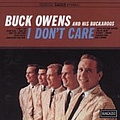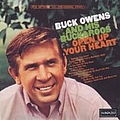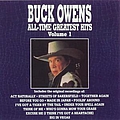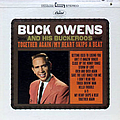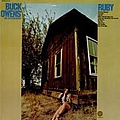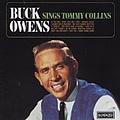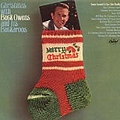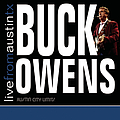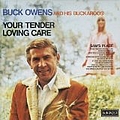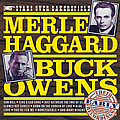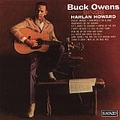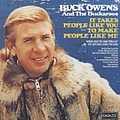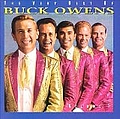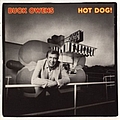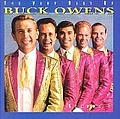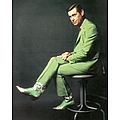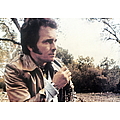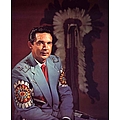Buck Owens Biography
Alvis Edgar "Buck" Owens, Jr., (August 12, 1929 – March 25, 2006) was an American singer and guitarist, with twenty number-one hits on the Billboard magazine country music charts. Both as a solo artist and with his band, the Buckaroos (so named by his onetime bandmate, Merle Haggard), Buck Owens pioneered what has come to be called the Bakersfield sound—a reference to Bakersfield, California, the city Owens called home and from which he drew inspiration for what he preferred to call "American Music".[1] Owens co-hosted the popular and groundbreaking Hee Haw program with Roy Clark. Hee Haw, originally envisioned as country music's answer to Laugh-In, outlived that show and ran for twenty-four seasons. www.buckowens.com/aboutbuck.html Buck Owens From Wikipedia, the free encyclopedia Birth name Alvis Edgar Owens, Jr. Born August 12, 1929 Origin Sherman, Texas Died March 25, 2006 (aged 76) Bakersfield, California Genres country, Bakersfield sound Occupations singer, bandleader, TV host Instruments vocals, guitar Years active 1945–2006 Labels Capitol Records, Sundazed Records Associated acts The Buckaroos, Susan Raye, Rose Maddox Alvis Edgar Owens, Jr. (August 12, 1929 – March 25, 2006), better known as Buck Owens, was an American singer and guitarist who had 21 number one hits on the Billboard country music charts with his band, the Buckaroos. They pioneered what came to be called the Bakersfield sound—a reference to Bakersfield, California, the city Owens called home and from which he drew inspiration for what he preferred to call American music.[1] While Owens originally used fiddle and retained pedal steel guitar into the 1970s, his sound on records and onstage was always more stripped-down and elemental, incorporating elements of rock and roll. His signature style was based on simple storylines, infectious choruses, a twangy electric guitar, an insistent rhythm supplied by a drum track placed forward in the mix, and high two-part harmonies featuring Owens and his guitarist Don Rich.[2] Beginning in 1969, Owens co-hosted the TV series Hee Haw with Roy Clark. He left the cast in 1986, convinced that the show's exposure had obscured his musical legacy.[citation needed] In 1974, the accidental death of Rich, his best friend, devastated him for years and abruptly halted his career until he performed with Dwight Yoakam in 1988. Owens died on March 25, 2006 shortly after performing at his Crystal Palace restaurant, club and museum in Bakersfield. Owens is a member of the Country Music Hall of Fame and the Nashville Songwriters Hall of Fame. Biography Owens was born on a farm in Sherman, Texas to Alvis Edgar Owens, Sr. and his wife Maicie Azel Ellington.[3] Midway Mall, at 4800 Texoma Parkway, now sits where his farm once was. (U.S. Highway 82 through Sherman was named Buck Owens Freeway in his honor). "'Buck' was a donkey on the Owens farm," Rich Kienzle wrote in the biography About Buck.[4] "When Alvis, Jr., was three or four years old, he walked into the house and announced that his name was also Buck. That was fine with the family; the boy was Buck from then on."[5] He attended public school for grades 1–3 in Garland, Texas.[6] In 1937, his family moved to Mesa, Arizona, during the Dust Bowl and the Great Depression. Early career In 1945, Owens co-hosted a radio show called Buck and Britt. In the late 1940s, he became a truck driver and drove through the San Joaquin Valley of California. He was impressed by Bakersfield, where he and his wife settled in 1950.[citation needed] Soon, Owens was frequently traveling to Hollywood for session recording jobs at Capitol Records, playing backup for Tennessee Ernie Ford, Sonny James, Wanda Jackson, Del Reeves, Tommy Sands, Tommy Collins, Faron Young and Gene Vincent, and many others.[citation needed] Owens recorded a rockabilly record called "Hot Dog" for the Pep label, using the pseudonym Corky Jones because he did not want the fact he recorded a rock n' roll tune to hurt his country music career.[citation needed] Sometime in the 1950's, he lived with his second wife and children in Fife Washington, where he sang with the non- famous Dusty Rhodes band. Owens' career took off in 1959, when his song "Second Fiddle" hit No. 24 on the Billboard country chart. A few months later, "Under Your Spell Again" hit No. 4, and then "Above and Beyond" hit No. 3. On April 2, 1960 he performed the song on ABC-TV's Ozark Jubilee. In the early 1960s, the countrypolitan sound was popular, with smooth, string-laden, pop-influenced styles used by Eddy Arnold, Jim Reeves, and Patsy Cline, among others. Owens went against the trend, utilizing honky tonk hillbilly feel, mixed idiosyncratically with the Mexican polkas he had heard on border radio stations while growing up.[citation needed] Owens was named the Most Promising Country and Western Singer of 1960 by Billboard.[citation needed] In 1961, his top 10-charting duets with Rose Maddox earned them awards as vocal team of the year.[citation needed] [edit]At the top 1963's "Act Naturally" became Owens and the Buckaroos' first No. 1 hit. The Beatles later recorded a cover of it in 1965. Ringo Starr later re-recorded the song as a duet with Owens in 1988.[7] Owens met his longtime guitarist Don Rich in the Seattle area.[8] The 1966 album Carnegie Hall Concert was a smash hit and further cemented Buck Owens and the Buckaroos as more than just another honky tonk country band. They achieved crossover success on to the pop charts.[citation needed] During that year, R&B singer Ray Charles released cover versions of two of Owens' songs that became pop hits: "Crying Time" and "Together Again". In 1967, Owens and the Buckaroos toured Japan, a then-rare occurrence for a country musician.[citation needed] The subsequent live album, appropriately named Buck Owens and His Buckaroos in Japan, is the first country music album recorded outside the United States.[9] In 1968 Owens and the Buckaroos performed for President Lyndon Baines Johnson at the White House, which was later released as a live album. Between 1968–1969, steel pedal guitar player Tom Brumley and drummer Willie Cantu left the band. Drummer Jerry Wiggins and steel pedal guitar player Jay Dee Maness were added to the band. Owens and the Buckaroos had two songs reach No. 1 on the country music charts in 1969, "Tall Dark Stranger" and "Who's Gonna Mow Your Grass". In 1969, they recorded a live album, Live in London, where they premiered their rock song "A Happening In London Town" and their version of Chuck Berry's song "Johnny B. Goode". During this time Hee Haw, starring Owens and the Buckaroos, was at its height of popularity. The series, originally envisioned as country music's answer to Laugh-In, outlived that show and ran for 24 seasons. In the early 1970s, Owens and the Buckaroos enjoyed a string of hit duets with his protege Susan Raye, who subsequently became a popular solo artist with recordings produced by Owens. In 1971, the Buckaroos' bass guitarist Doyle Holly left the band to pursue a solo career. Holly was known for his solo ballads with his trademark booming deep voice on Buck Owens and the Buckaroos albums. His departure was a setback to the band, as Doyle had received the Bass Player of the Year award from the Academy of Country Music the year before in 1970 and served as co-lead vocalist (along with Don Rich) of the Buckaroos.[citation needed] Holly went on to record two solo records in the early 1970s, both were top 20 hits. Holly has subsequently been honored in the Rockabilly Hall of Fame and with a block in the Walkway of Stars at the Country Music Hall of Fame. Owens and Rich were the only original members left of Buck Owens and the Buckaroos, and in the 1970s they struggled to top the country music charts. However, the popularity of Hee Haw was allowing them to enjoy large crowds at indoor arenas. In 1972, Owens and the Buckaroos finally had another No. 1 hit, "Made in Japan", after three years of not having a number one song. In April, he added pedal steel guitarist, Jerry Brightman. The band had been without pedal steel since late in 1969 when Maness departed, and Owens returned to his grass roots sound of fiddle, steel, and electric guitars releasing a string of singles including "Arms Full of Empty", "Ain't it Amazing Gracie" and "Ain't Gonna Have Ole Buck (to Kick Around no More)". Owens' original release of "Streets of Bakersfield" was released in 1972. On July 17, 1974, Owens' best friend and Buckaroos guitarist Don Rich was killed when he lost control of his motorcycle and struck a guard rail on Highway 99 north of Bakersfield. Rich had been on his way to join his family for vacation on the coast at Morro Bay. Owens was devastated. "He was like a brother, a son and a best friend," he said in the late 1990s. "Something I never said before, maybe I couldn't, but I think my music life ended when he did. Oh yeah, I carried on and I existed, but the real joy and love, the real lightning and thunder is gone forever."[10] Before the 1960s were done, Owens—with the help of manager Jack McFadden—began to concentrate on his financial future. He bought several radio stations, including KNIX-AM and KNIX-FM in Phoenix and KUZZ in Bakersfield. In 1999, Owens sold the KNIX stations to Clear Channel Communications, but he maintained ownership of KUZZ until his death. Owens established Buck Owens Enterprises and produced records by several artists. He recorded for Warner Bros. Records, but Owens and his longtime fans were less than happy with the results; the recordings, made in Nashville, reflected the very type of bland country music he had always assailed. His spirit broken by the depression of Rich's death, he simply allowed himself to be led. He was no longer recording by the 1980s, devoting his time to overseeing his business empire from Bakersfield. Slowly, during that time, he recovered his equilibrium. Time allowed him to realize that despite the excellent pay and friendships he'd developed on Hee Haw, the show effectively ruined his musical career by redefining him as a comedian, to the point that many who tuned in knew nothing of his country music career or his classic hit recordings. He left the show in 1986. Later career Dwight Yoakam was largely influenced by Owens' style of music and eventually teamed up with him for a duet of "Streets of Bakersfield" in 1988. Their duet was Owens' first No. 1 single in 16 years. The 1990s saw a flood of reissues of his Capitol recordings on compact disc. In 1974, Owens had bought back publishing rights to all of his Capitol recordings, as part of his final contract with the label. His albums had been out of print for nearly 15 years, when he released a retrospective box set in 1990. Encouraged by brisk sales, Owens struck a distribution deal with Sundazed Records of New York, which specializes in reissuing obscure recordings. The bulk of his Capitol catalog was reissued on CD in 1995, 1997 and in 2005. Sometime in the 1970s, Owens had also purchased the remaining copies of his original LP albums from Capitol's distribution warehouses across the country. Many of those records (still in the shrinkwrap) were stored by Owens for decades. He often gave them away as gifts and sold them at his nightclub for a premium price some 35 years later. In August 1999, Owens brought back together the remaining members of his original Buckaroo Band to help him celebrate his 70th birthday at Owens' Crystal Palace in Bakersfield. All the original surviving Buckaroos were there: Owens, Doyle Holly, Tom Brumley, and Wille Cantu performed old hits from their heyday including "Tiger by the Tail" and "Act Naturally." Owens was inducted into the Country Music Hall of Fame in 1996. He was ranked No. 12 in CMT's 40 Greatest Men of Country Music in 2003. In addition, CMT also ranked the Buckaroos No. 2 in the netwok's 20 Greatest Bands in 2005. Long before Owens became the famous co-host of Hee Haw, his band became known for their signature Bakersfield sound, later emulated by artists such as Merle Haggard, Dwight Yoakam and Brad Paisley. This sound was originally made possible with two trademark silver-sparkle Fender Telecaster guitars, often played simultaneously by Owens and longtime wing-man Don Rich; Fender had made a "Buck Owens signature Telecaster," and after his death paid tribute to him. In 2003, Paisley blended creative styles with this guitar and his own famous Paisley Telecaster, creating what became known as the Buck-O-Caster. Initially, only two were made; one for Paisley himself and the other presented to Owens during a New Year's celebration that Paisley attended in 2004. Following the death of Rich, Owens' latter trademark was a red, white and blue acoustic guitar, along with a 1974 Pontiac convertible "Nudiemobile", adorned with pistols and silver dollars. A similar car, created by Nudie Cohn for Elvis Presley and later won by Owens in a bet, is now enshrined behind the bar at Owens' Crystal Palace Nightclub in Bakersfield. Owens would hand out replicas of his trademark acoustic guitar to friends, acquaintances and fans. Each would contain a gold plaque with the name of the recipient. Some of these guitars cost $1000 and up. ]Death Buck Owens died in his sleep of an apparent heart attack on March 25, 2006, only hours after performing at his Crystal Palace restaurant, club and museum in Bakersfield. He had successfully recovered from oral cancer in the early 1990s, but had additional health problems near the end of the 1990s and the beginning of the 21st century, including pneumonia and a minor stroke suffered in 2004. These health problems had forced him to curtail his regular weekly performances with the Buckaroos at his Crystal Palace. The Los Angeles Times interviewed longtime Owens spokesman (and Buckaroos keyboard player) Jim Shaw, who said Owens "had come to the club early and had a chicken-fried steak dinner and bragged that it's his favorite meal." Afterward, Owens told band members that he wasn't feeling well and was going to skip that night's performance. Shaw said a group of fans introduced themselves while Owens was preparing to drive home; when they told him that they had traveled from Oregon to hear him perform, Owens changed his mind and took the stage anyway. Shaw recalled Owens telling the audience, "If somebody's come all that way, I'm gonna do the show and give it my best shot. I might groan and squeak, but I'll see what I can do." Shaw added, "So, he had his favorite meal, played a show and died in his sleep. We thought, that's not too bad."[12] The front of the mausoleum where Owens is buried is inscribed "The Buck Owens Family" with the word's "Buck's Place" beneath.
Top Buck Owens Lyrics
Write a comment
What do you think about Buck Owens? Let us know in the comments below!
Top Buck Owens Albums
Similar artists
- George JonesCountry
- Merle HaggardCountry
- Ray PriceCountry
- Ernest TubbCountry
- Webb PierceCountry
- Lefty FrizzellCountry
- Faron YoungCountry
- Dwight YoakamCountry
- Hank SnowCountry
- Johnny Paycheck70s/Country
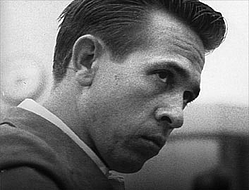






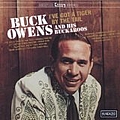


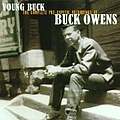
![Buck Owens - The Buck Owens Collection (1959-1990) [disc 2] album Buck Owens - The Buck Owens Collection (1959-1990) [disc 2] album](http://img2.motolyrics.com/2/42/24282/buck-owens-the-buck-owens-collection-1959-1990-disc-2-large.jpg)
